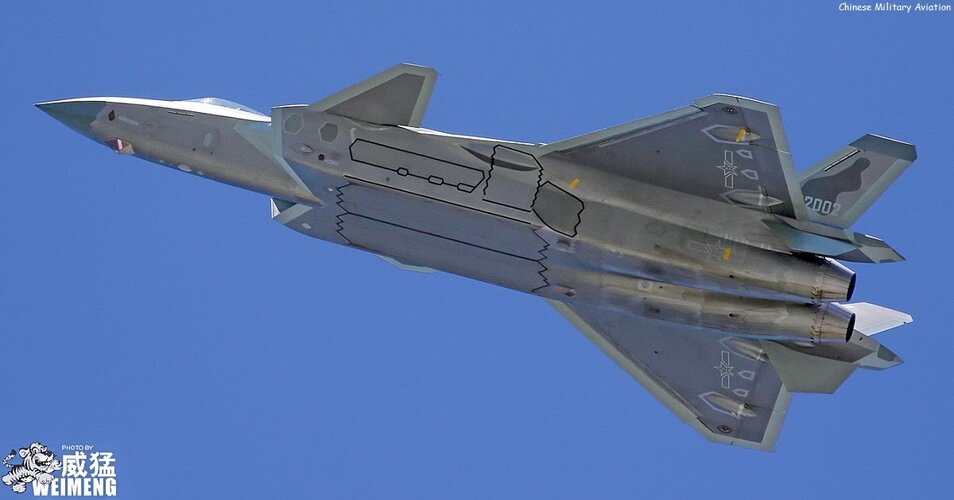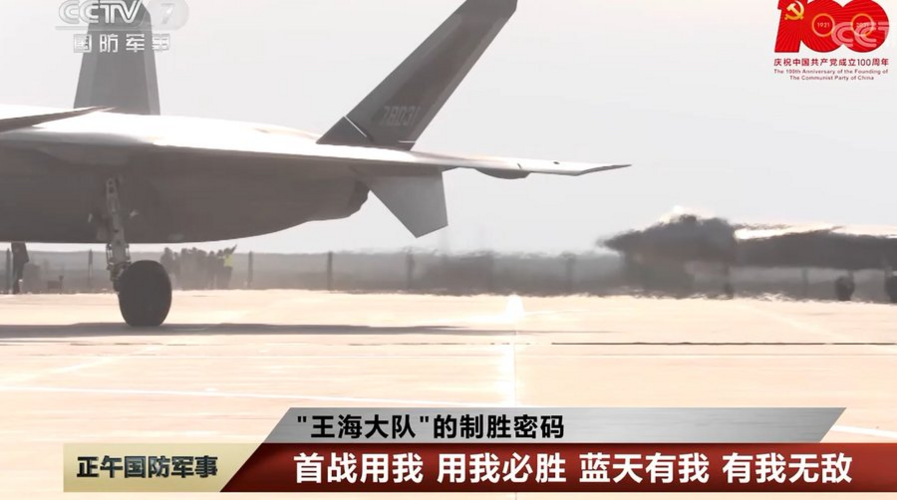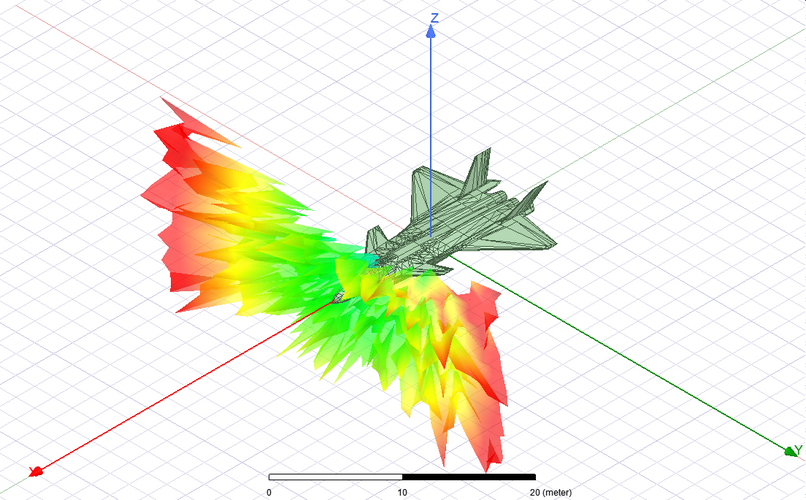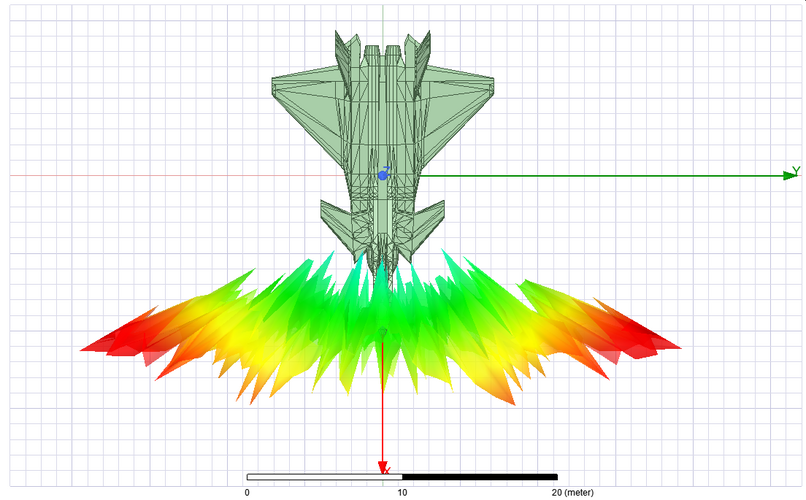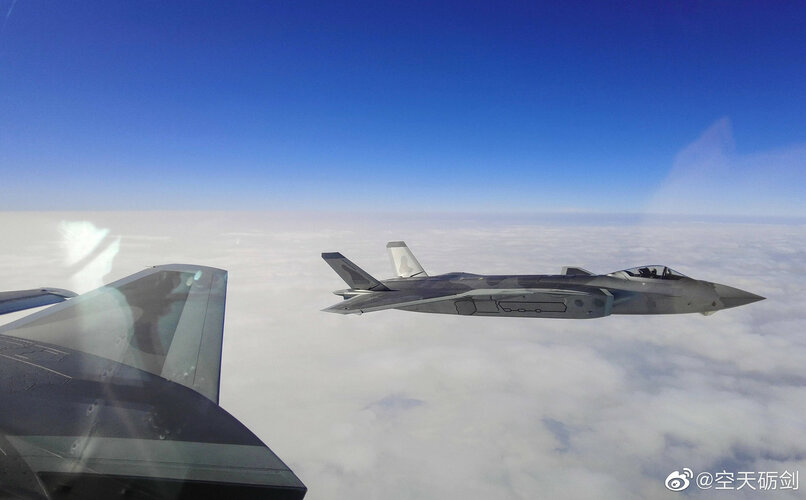You are using an out of date browser. It may not display this or other websites correctly.
You should upgrade or use an alternative browser.
You should upgrade or use an alternative browser.
Chengdu J-20 news and analysis Part III
- Thread starter overscan (PaulMM)
- Start date
siegecrossbow
I really should change my personal text
- Joined
- 12 March 2012
- Messages
- 704
- Reaction score
- 2,095
- Joined
- 2 January 2006
- Messages
- 3,799
- Reaction score
- 4,891
Another J-20 with WS-10 engines (serrated black nozzles) spotted, this time in Cangzhou?
View attachment 659708
Yes, 1st dadui within the 172nd Air Brigade PLAAF Cangzhou Flight Training Base, and it formerly flew Su-30MKK.
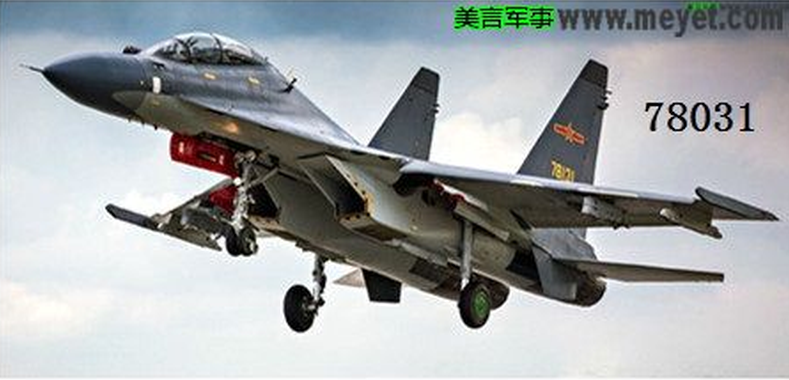
- Joined
- 11 February 2010
- Messages
- 1,636
- Reaction score
- 2,639
Real TVC or just illusion from light ?
View: https://twitter.com/alert5/status/1410158502350229505
Still interesting tho.
Having TVC can means shorter take-off runs, and some might complain that the engine separation is not "wide" enough. But still i think there is still benefit in dive and pitch plus if the TVC is KLIVT like demonstrated in at least 1 Salyut AL-31FM engine, it might even allow maneuvering to be done without movement of control surface.
View: https://twitter.com/alert5/status/1410158502350229505
Still interesting tho.
Having TVC can means shorter take-off runs, and some might complain that the engine separation is not "wide" enough. But still i think there is still benefit in dive and pitch plus if the TVC is KLIVT like demonstrated in at least 1 Salyut AL-31FM engine, it might even allow maneuvering to be done without movement of control surface.
- Joined
- 2 January 2006
- Messages
- 3,799
- Reaction score
- 4,891
Real TVC or just illusion from light ?
View: https://twitter.com/alert5/status/1410158502350229505
Still interesting tho.
Having TVC can means shorter take-off runs, and some might complain that the engine separation is not "wide" enough. But still i think there is still benefit in dive and pitch plus if the TVC is KLIVT like demonstrated in at least 1 Salyut AL-31FM engine, it might even allow maneuvering to be done without movement of control surface.
Actually I'm now almost convinced this is NOT the alleged WS-15-powered prototype - since as per the latest news that aircraft that flew in its "final form" was most likely the KJ-600 - but the prototype fitted with a single WS-10B-3 as on the TVC-demonstrator J-10B '1034' and which is rumoured to be flying since late 2019.
- Joined
- 29 November 2010
- Messages
- 1,765
- Reaction score
- 3,456
- Joined
- 21 April 2009
- Messages
- 13,705
- Reaction score
- 7,563
China Upgrading Fifth-Gen Fighter Capabilities
China Upgrading Fifth-Gen Fighter Capabilities
Cannonfodder43
ACCESS: Confidential
- Joined
- 8 December 2019
- Messages
- 115
- Reaction score
- 301
Not to keep beating on what may be a dead horse and I hope I am not derailing the thread but I find it very annoying that sources like RUSI or The Drive talk so casually about removing the canards.The removal of canards combined with changes to the wing shape could improve the stealth characteristics of the aircraft.
The J-20's configuration relies heavily on the canards for efficient controlled stable flight and satisfactory agility as per Dr Song Wecong's paper that basically described the J-20. It would need to be rebuilt from the ground up into a completely different aircraft.
As per the other stated opinions quoted in the article, the J-20 may have more prominent radar spikes, but I imagine it would still be difficult to rely on them. Given that the radar spikes will change with aspect and the AMRAAM's small seekers would not be that useful without getting really, really close.
- Joined
- 11 February 2010
- Messages
- 1,636
- Reaction score
- 2,639
On radar spike respect tho.. i wonder why nobody seems to invest in replicating what Ausairpower did with J-20 analysis.
siegecrossbow
I really should change my personal text
- Joined
- 12 March 2012
- Messages
- 704
- Reaction score
- 2,095
On radar spike respect tho.. i wonder why nobody seems to invest in replicating what Ausairpower did with J-20 analysis.
I think that bar might be too high for casual military fans. As for professionals, you can be sure that they’ve done analysis via metal models. However, that doesn’t account for things like material (stealth coating, radar absorbing material, etc.).
Take for instance the canards on the J-20. Going by casual analysis there is no planform alignment with the rear edge of the main wings, which should contribute to higher returns. However, if you look at a yellow primer bird, it is obvious that there is sawtooth treatment on the rear edge of the canards and trailing edge of the main wings, which in combination with what appears to RAM on the edge, should attenuate radar returns.
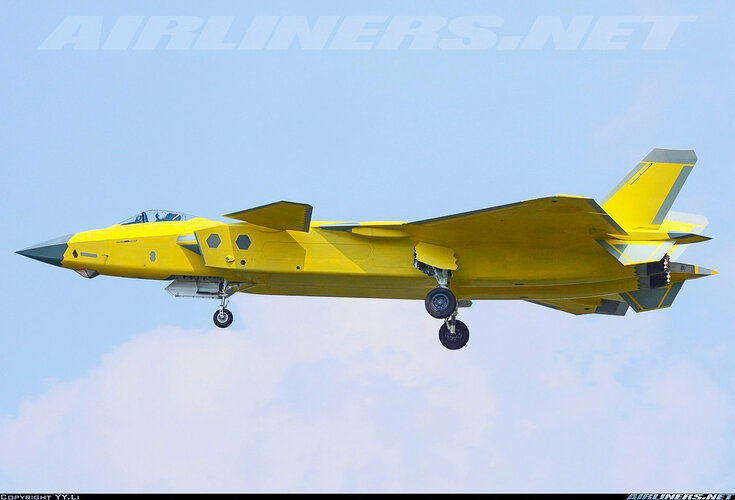
- Joined
- 11 February 2010
- Messages
- 1,636
- Reaction score
- 2,639
On radar spike respect tho.. i wonder why nobody seems to invest in replicating what Ausairpower did with J-20 analysis.
I think that bar might be too high for casual military fans. As for professionals, you can be sure that they’ve done analysis via metal models. However, that doesn’t account for things like material (stealth coating, radar absorbing material, etc.).
Yeah. tho i wish those RUSI analysts or anyone actually writing those stuff in magazine can actually attain that standard. These people may often have considerable financial or can actually "borrow" the proper tools from the authority.
siegecrossbow
I really should change my personal text
- Joined
- 12 March 2012
- Messages
- 704
- Reaction score
- 2,095
On radar spike respect tho.. i wonder why nobody seems to invest in replicating what Ausairpower did with J-20 analysis.
I think that bar might be too high for casual military fans. As for professionals, you can be sure that they’ve done analysis via metal models. However, that doesn’t account for things like material (stealth coating, radar absorbing material, etc.).
Yeah. tho i wish those RUSI analysts or anyone actually writing those stuff in magazine can actually attain that standard. These people may often have considerable financial or can actually "borrow" the proper tools from the authority.
If they could or has the financial means to "borrow" the proper tools, they wouldn't have to write for magazines
Reminds me of the journalist saying that the TVC the Russians use creates more drag because they swing at an outward angle instead of up and down like the f-22... Ok, what is the explanation for it? non mention it.
- Joined
- 27 December 2005
- Messages
- 17,664
- Reaction score
- 25,689
Even casual analysis ought to show that the canard trailing edge is aligned to the rear edge of the opposite wing. It's pretty clear from a top view.On radar spike respect tho.. i wonder why nobody seems to invest in replicating what Ausairpower did with J-20 analysis.
I think that bar might be too high for casual military fans. As for professionals, you can be sure that they’ve done analysis via metal models. However, that doesn’t account for things like material (stealth coating, radar absorbing material, etc.).
Take for instance the canards on the J-20. Going by casual analysis there is no planform alignment with the rear edge of the main wings, which should contribute to higher returns. However, if you look at a yellow primer bird, it is obvious that there is sawtooth treatment on the rear edge of the canards and trailing edge of the main wings, which in combination with what appears to RAM on the edge, should attenuate radar returns.
View attachment 660406
Last edited:
siegecrossbow
I really should change my personal text
- Joined
- 12 March 2012
- Messages
- 704
- Reaction score
- 2,095
Even casual analysis ought to show that the canard trailing edge is aligned to the rear edge of the opposite wing. It's pretty clear from a top view.On radar spike respect tho.. i wonder why nobody seems to invest in replicating what Ausairpower did with J-20 analysis.
I think that bar might be too high for casual military fans. As for professionals, you can be sure that they’ve done analysis via metal models. However, that doesn’t account for things like material (stealth coating, radar absorbing material, etc.).
Take for instance the canards on the J-20. Going by casual analysis there is no planform alignment with the rear edge of the main wings, which should contribute to higher returns. However, if you look at a yellow primer bird, it is obvious that there is sawtooth treatment on the rear edge of the canards and trailing edge of the main wings, which in combination with what appears to RAM on the edge, should attenuate radar returns.
View attachment 660406
Interesting. I never looked at it that way before.
- Joined
- 27 December 2005
- Messages
- 17,664
- Reaction score
- 25,689
Rearwards, its not terribly relevant at most angles, but trailing edges create noticeable spikes in the forward sector as well. This was one of the key stealth realisations, and one of the flaws in the A-12 Avenger and various early 80s "flying wing" bomber designs.Even casual analysis ought to show that the canard trailing edge is aligned to the rear edge of the opposite wing. It's pretty clear from a top view.On radar spike respect tho.. i wonder why nobody seems to invest in replicating what Ausairpower did with J-20 analysis.
I think that bar might be too high for casual military fans. As for professionals, you can be sure that they’ve done analysis via metal models. However, that doesn’t account for things like material (stealth coating, radar absorbing material, etc.).
Take for instance the canards on the J-20. Going by casual analysis there is no planform alignment with the rear edge of the main wings, which should contribute to higher returns. However, if you look at a yellow primer bird, it is obvious that there is sawtooth treatment on the rear edge of the canards and trailing edge of the main wings, which in combination with what appears to RAM on the edge, should attenuate radar returns.
View attachment 660406
Interesting. I never looked at it that way before.
Dragon029
ACCESS: Top Secret
- Joined
- 17 March 2009
- Messages
- 881
- Reaction score
- 440
The sensor in question would very likely be similar in purpose to the F-22's MLD or possibly F-35's DAS sensors (depends on the sensor size / resolution and software), so they would be a fixed, wide-angle imaging-IR sensor. The system better described as the J-20's EOTS would be the forward-looking IRST under the nose, in the same place as the F-35's EOTS (the J-20's 'glass house' only has transparencies in the forward 180 degrees, so it presumably has limited utility as an air-to-ground sensor).Does the aperture moveable ?That's kind of large window for a small sensor ?
I wonder if it would fit bigger optics in the future.
The sensor must be as small as possible, the field of view as large as possible. That's what this is about.
- Joined
- 11 February 2010
- Messages
- 1,636
- Reaction score
- 2,639
If they could or has the financial means to "borrow" the proper tools, they wouldn't have to write for magazines.
That's a shame.
They could at least do something like i did. This is a quick and crude model of J-20 that i did... it's Crude. But it has the generic feature of J-20 mainly the Canard foreplanes.
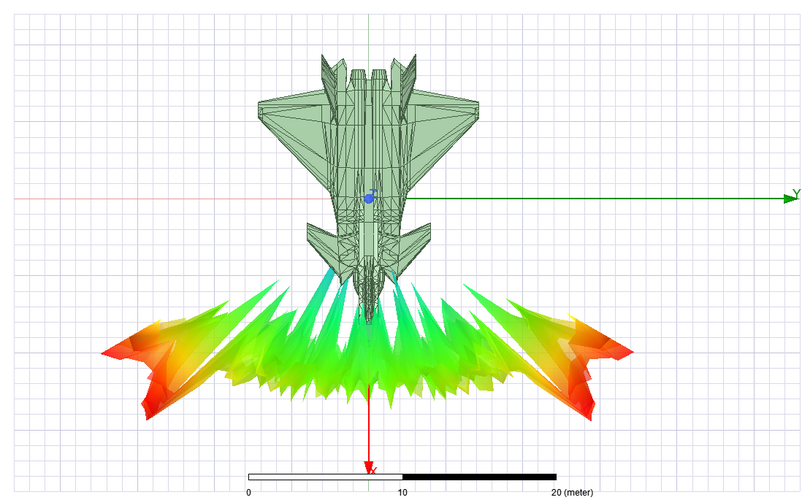
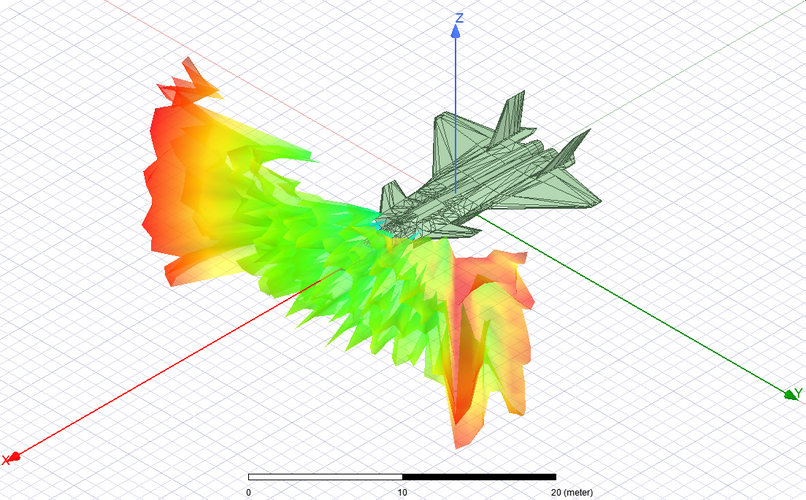
and 2D representative
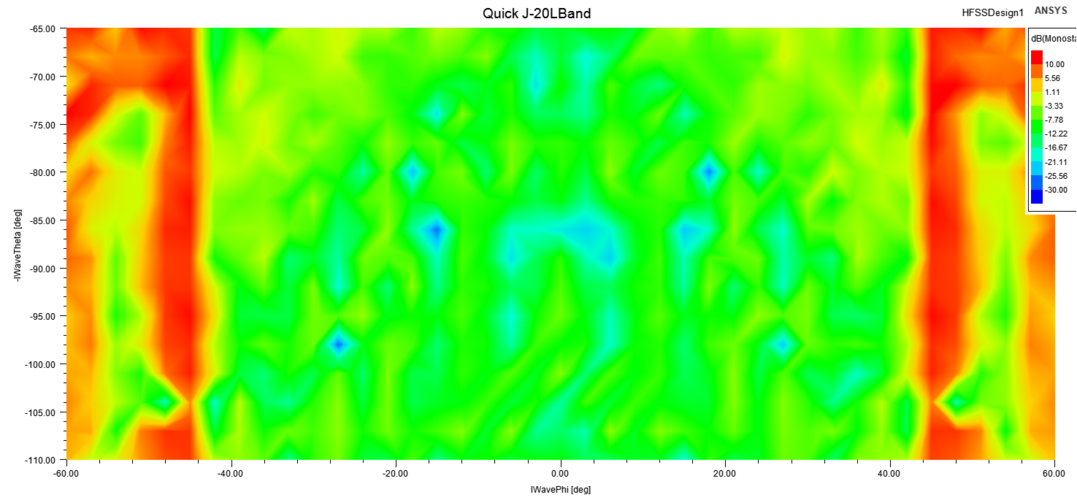
The estimates are done with following assumptions :
1.No RAM
2.L-band (1 GHz) because it's quick... and 3 degrees resolution so i dont need to work my PC overnight (I did and i'm worried as F)
3.The angle which i consider frontal is -60 to 60 degrees in horizontal direction (therefore 120 degrees of arc) and 65-110 degrees vertical which from experience seems to cover most of the cockpit down to angle most likely to be "seen" by ground based radar.
4.Intake is not considered, thus it is treated with "perfect RAM" which is a vacuum.
Well and there are spikes from the canard, wing leading edge and the wing itself but they're start to appear at about 45 degrees angle. The discussion can then be more productive on probable expected threat that will come.
---------
This is a followup. In case anyone asking where does the canard goes in X-band.
Same model, same assumptions. These are the X-band "view" of the spikes.
The spikes can still be seen to be at about 45 degrees angle but with noticeable "break down" into smaller lobes which spread in several directions. The following depicts the 2D projection of the above.
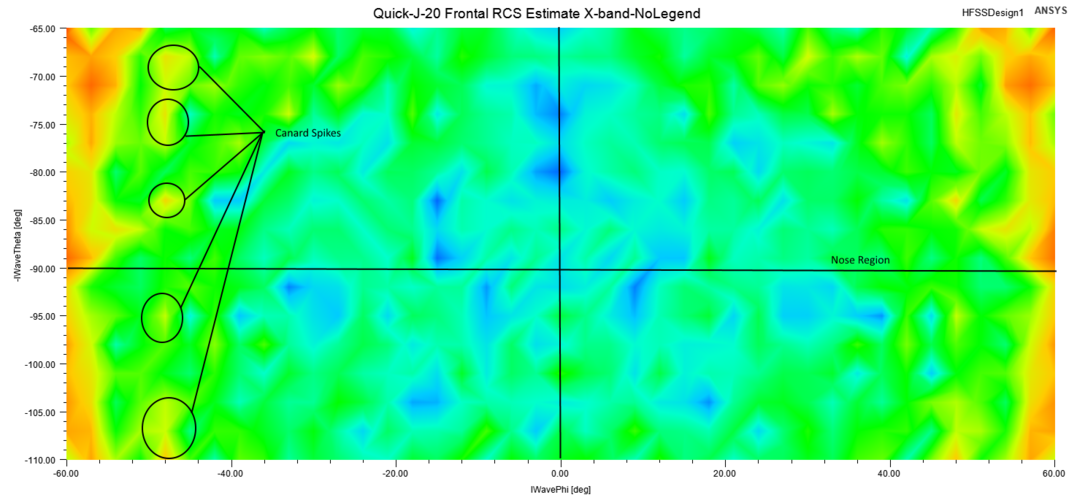
As seen the canard lobes are spread into smaller but relatively stronger lobes. However considering the apparent spread angle. There would be no visible "spikes" at head on aspect. The potential interceptor have to be in at least 45 degrees angle and be slightly higher or lower than the planes for the spikes to be detectable.
This i think further reinforces that the threat angle assumption should be the point on any further discussions on J-20 or any other stealth fighter (Yes.. MIUS i see you) that would make use of a Canard.
If the threat angle expected by the PLAAF is 90 degrees of arc (-45 to 45) the current J-20 designs easily satisfies that merit. The canard spikes can be further treated with radar absorbers which would weaken or even break the spikes into smaller even weaker spikes which would be harder to detect.
At L-band and above however as visible from the model, the spikes would "merge" with other spikes from perhaps the wing leading edge or the wing itself, creating more prominent lobes at 45 degrees angle which can essentially be detected from any altitude.
Last edited:
- Joined
- 11 February 2010
- Messages
- 1,636
- Reaction score
- 2,639
Well citing from @Deino Sorry X3.
View: https://twitter.com/RupprechtDeino/status/1424803964592197637
This is interesting. I wonder what role does the J-20 take in the exercise. Nonetheless the Russian could have unique opportunity to observe J-20's.
View: https://twitter.com/RupprechtDeino/status/1424803964592197637
This is interesting. I wonder what role does the J-20 take in the exercise. Nonetheless the Russian could have unique opportunity to observe J-20's.
siegecrossbow
I really should change my personal text
- Joined
- 12 March 2012
- Messages
- 704
- Reaction score
- 2,095
Well citing from @Deino Sorry X3.
View: https://twitter.com/RupprechtDeino/status/1424803964592197637
This is interesting. I wonder what role does the J-20 take in the exercise. Nonetheless the Russian could have unique opportunity to observe J-20's.
China and Russia have very different exercise rubrics and I think it is unlikely that there will be aerial combat exercises pitting J-20s against Su-30SMs. My personal opinion is that intercepting target drones together during live fire air defense exercise is probably the upper ceiling.
As for observing Chinese assets, the Chinese are pretty generous with the latest ground based assets and have not only allowed the Russians to operate them, but developed Russian manuals/instruction videos for them as well. Not sure about aerial assets.
p.s. Addendum. Seems like this exercise might be different. China, according to a Chinese commander, will use J-20 and J-16 with KJ-500 support as a combat system.
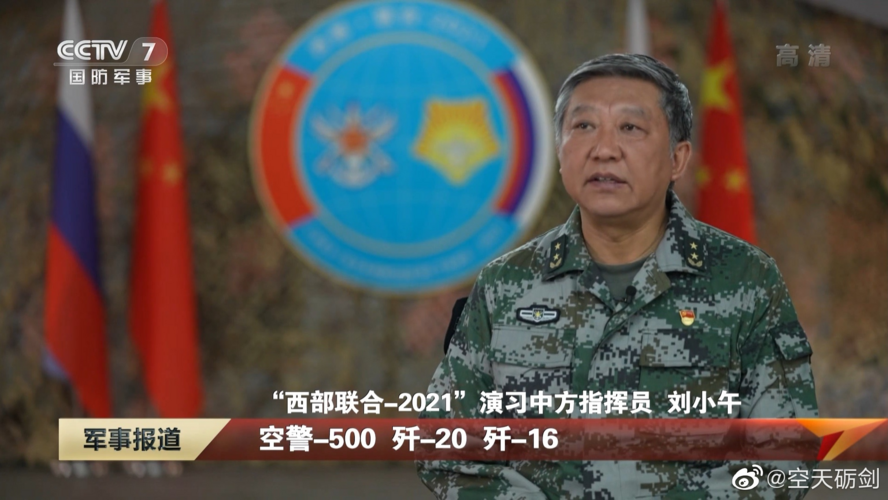
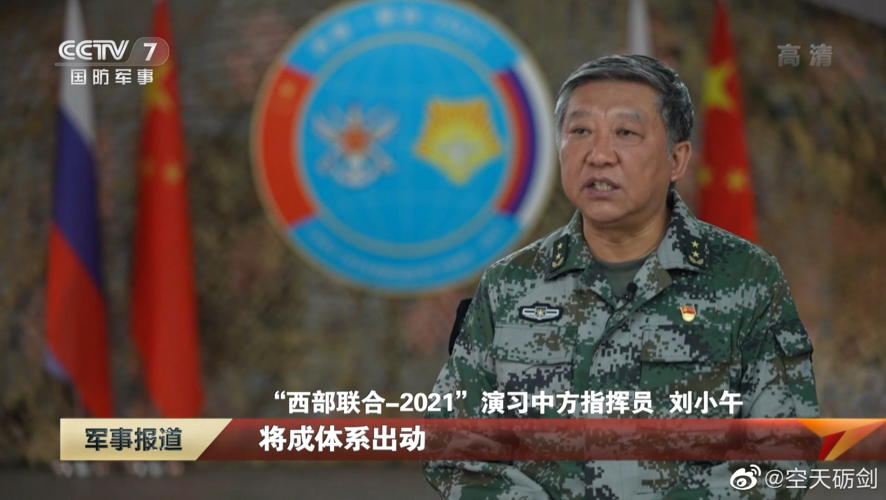
Last edited:
Something along the lines of detecting target drones?China, according to a Chinese commander, will use J-20 and J-16 with KJ-500 support as a combat system
siegecrossbow
I really should change my personal text
- Joined
- 12 March 2012
- Messages
- 704
- Reaction score
- 2,095
Something along the lines of detecting target drones?China, according to a Chinese commander, will use J-20 and J-16 with KJ-500 support as a combat system
We'll know in three days... or never.
Wouldn't count on the Russians to stay quiet forever.We'll know in three days... or never.
Cannonfodder43
ACCESS: Confidential
- Joined
- 8 December 2019
- Messages
- 115
- Reaction score
- 301
Based on limited footage of the J-20 seen around, the J-20 appears to possess good low speed maneuverability. In terms of acceleration and other performance metrics, it remains unknown. Although it appears slightly more sluggish in those regards compared to the F-22 and Su-57 but given the engines it has to work with, it does well with what it has.In general, does anyone know what the J-20's maneuverability performance realm is like in regards to the F-22 and the Su-57? Have not been keeping up with this platform lately.
Can you also try it if the canards were coplanar to the opposite wing, as well as with the ventrals and tailfin removed?
If they could or has the financial means to "borrow" the proper tools, they wouldn't have to write for magazines.
That's a shame.
They could at least do something like i did. This is a quick and crude model of J-20 that i did... it's Crude. But it has the generic feature of J-20 mainly the Canard foreplanes.
View attachment 660434
View attachment 660435
and 2D representative
View attachment 660438
The estimates are done with following assumptions :
1.No RAM
2.L-band (1 GHz) because it's quick... and 3 degrees resolution so i dont need to work my PC overnight (I did and i'm worried as F)
3.The angle which i consider frontal is -60 to 60 degrees in horizontal direction (therefore 120 degrees of arc) and 65-110 degrees vertical which from experience seems to cover most of the cockpit down to angle most likely to be "seen" by ground based radar.
4.Intake is not considered, thus it is treated with "perfect RAM" which is a vacuum.
Well and there are spikes from the canard, wing leading edge and the wing itself but they're start to appear at about 45 degrees angle. The discussion can then be more productive on probable expected threat that will come.
---------
This is a followup. In case anyone asking where does the canard goes in X-band.
Same model, same assumptions. These are the X-band "view" of the spikes.
View attachment 661504 View attachment 661505 The isometric or trimetric view the top view
The spikes can still be seen to be at about 45 degrees angle but with noticeable "break down" into smaller lobes which spread in several directions. The following depicts the 2D projection of the above.
View attachment 661506
As seen the canard lobes are spread into smaller but relatively stronger lobes. However considering the apparent spread angle. There would be no visible "spikes" at head on aspect. The potential interceptor have to be in at least 45 degrees angle and be slightly higher or lower than the planes for the spikes to be detectable.
This i think further reinforces that the threat angle assumption should be the point on any further discussions on J-20 or any other stealth fighter (Yes.. MIUS i see you) that would make use of a Canard.
If the threat angle expected by the PLAAF is 90 degrees of arc (-45 to 45) the current J-20 designs easily satisfies that merit. The canard spikes can be further treated with radar absorbers which would weaken or even break the spikes into smaller even weaker spikes which would be harder to detect.
At L-band and above however as visible from the model, the spikes would "merge" with other spikes from perhaps the wing leading edge or the wing itself, creating more prominent lobes at 45 degrees angle which can essentially be detected from any altitude.
One of my hobbyhorses is that the J-20 is eventually going to evolve into an X-36-type configuration once TVC has matured. The J-20 design was made with China's weak engines (if J-20s with WS-15s come online by 2025, they'll be 20 years behind the Americans) in mind, and compromises were made since they can't simply rely on engine power to solve all factors.
From available leaks, the J-20 was designed with a 60 degree max AoA (and the failed Shenyang proposal was capable of 65 degrees max AoA). Rumors have the J-20 being capable of even higher max AoA, although I've failed to find citations on what its actual max AoA is. The combination of canards and a dragging tailfin, according to RCPowers, provides extreme stability at high AoA should TVC be added. But if TVC is added, the J-20 can perhaps drop its tailfins and ventral fins, relying instead on the TVC to provide high AoA control. That would improve stealth and reduce drag, further improving performance.
That might be the final goal of the J-20 program; i.e, it's stealth-hobbled in some ways, but its stealth can be further improved to levels at least competitive with the F-22 and F-35 should the tailfins be removed.
Also, via SDF, there are rumors of a J-20 with TVC and modified DSI flying around. My stance is that the WS-15 will have different mass air flow requirements than the WS-10 / AL-31, and thus will require modification to the intake. Modified DSI is a strong sign that the WS-15 is at least in testing at present.
- Joined
- 11 February 2007
- Messages
- 2,490
- Reaction score
- 4,145
Not to keep beating on what may be a dead horse and I hope I am not derailing the thread but I find it very annoying that sources like RUSI or The Drive talk so casually about removing the canards.The removal of canards combined with changes to the wing shape could improve the stealth characteristics of the aircraft.
The J-20's configuration relies heavily on the canards for efficient controlled stable flight and satisfactory agility as per Dr Song Wecong's paper that basically described the J-20. It would need to be rebuilt from the ground up into a completely different aircraft.
Just casually taking the canards off would only work if the J-20 is either neutrally unstable or inherently stable in the canard-less configuration (ie centre of lift close to centre of mass). Which I find difficult to believe. For FBW agility you want a basically unstable aircraft that's prevented from instantly departing by either the canards or the horizontal tail. Canards do tend to shift the centre of lift forward, so I suppose they do allow a wing that's more stable on its own, but ideally you want the canards supplying control forces, not lift, in order to minimise their size. We've had designs (Kfir, various Mirage updates), where canards have been added in order to make an existing design less stable/more agile, but I can't think of a single example of taking canards off an existing canard design, because you design from the start for the canard and the wing working together.
If you want to take the canards off, the first thing you look at is not the canards, it's the entire wing, which you junk and start over. And then you take the FBW system and junk all your existing control laws, because you'll be rewriting those from scratch as well. Simple taking the canard off isn't.
F-22: 1.23 kgf/kg; 330 kg/m2
Su-57: 1.26 kgf/kg (izd.117) or 1.38 kgf/kg (izd.30); 310 kg/m2
J-20: 1.24 kgf/kg; 310 kg/m2
Su-57: 1.26 kgf/kg (izd.117) or 1.38 kgf/kg (izd.30); 310 kg/m2
J-20: 1.24 kgf/kg; 310 kg/m2
You're still going by 17500 kg empty weight, aren't you? Working off the F-22's relative dimensions (256.55 m^2 vs 270.396 m^2), and the J-20's 21% titanium content and assuming the Chinese used 3D-printed titanium to achieve a 40% weight reduction (claimed potential titanium weight reduction), the weight looks more like 18200 kg, which is 4% higher than yours. I go with 18500 kg empty weight myself.F-22: 1.23 kgf/kg; 330 kg/m2
Su-57: 1.26 kgf/kg (izd.117) or 1.38 kgf/kg (izd.30); 310 kg/m2
J-20: 1.24 kgf/kg; 310 kg/m2
The current measurements are roughly 20.88 length and 12.95 wingspan:
The main wing is about 76 m^2, canard area is 7-8m^2, perhaps 7.4 or 7.5 m^2, or 83-84 m^2 if canards were lift-producing (which is only true in a stable regime).
25,600 60% fuel (11,500 seems cited on Wikipedia, but we realyl don't know what the internal fuel capacity is) + 500 kg missiles, you get 336.8 kg/m^2 wing loading using main wing only, 306 kg/m^2 wing loading using main wing + canard lift. This is assuming 18,200 empty weight.
Attachments
Where do you get the rough dimensions from? Using a satellite / drone photo with J-16s on the same tarmac, the aircraft is roughly 20.88m by 12.95m.
Also, what's your source for the claimed 17,500 kg empty weight? The weight estimations are all topsy turvy, Trident, for instance, has 21.5 or environs tons for empty weight.
Who is this?The weight estimations are all topsy turvy, Trident, for instance, has 21.5 or environs tons for empty weight.
Just ping him, he's on this forum. There's currently a Chinese claim that the empty airframe is 15 tons, which seems unbelievable unless this is without electronics. Trident is more favoring a heavy weight, I'm more going for a moderate 18 tons range empty weight.Who is this?The weight estimations are all topsy turvy, Trident, for instance, has 21.5 or environs tons for empty weight.
- Joined
- 27 December 2005
- Messages
- 17,664
- Reaction score
- 25,689

J-20: The Stealth Fighter That Changed PLA Watching Forever
A decade after the J-20’s maiden flight, a look back at China’s fifth generation stealth fighter – and how it changed PLA watching forever.
thediplomat.com
BDF
ACCESS: Secret
- Joined
- 14 March 2009
- Messages
- 284
- Reaction score
- 423
Wonder why the doors have such dark outlines?
Similar threads
-
Shenyang FC-31 demonstrators / J-35 naval fighter / J-35A land-based version
- Started by Foxglove
- Replies: 964
-
-
-
-

